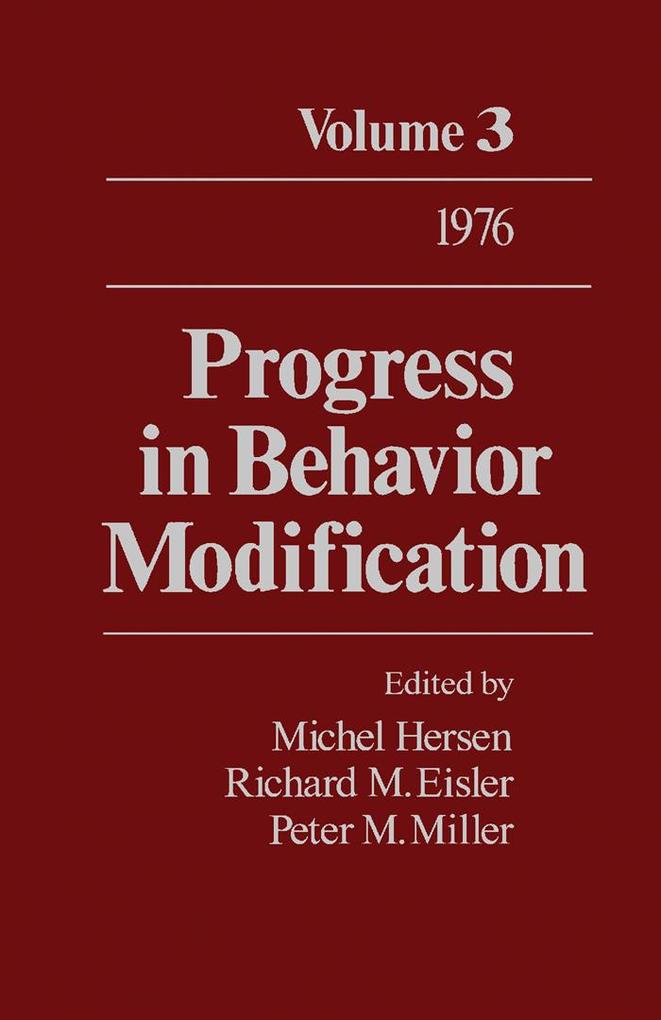
Sofort lieferbar (Download)
Progress in Behavior Modification, Volume 3, is a multidisciplinary serial publication that encompasses the contributions of psychology, psychiatry, social work, speech therapy, education, and rehabilitation. This serial aims to meet the need for a review publication that undertakes to present yearly in-depth evaluations that include a scholarly examination of theoretical underpinnings, a careful survey of research findings, and a comparative analysis of existing techniques and methodologies. The discussions center on a wide spectrum of child and adult disorders.
The present volume opens with a chapter on behavior modification and hypnosis. This is followed by separate chapters on applications of behavior modification procedures in classroom settings; smoking behavior modification; and psychotherapy outcome research. Subsequent chapters deal with the behavioral approach to teaching learning disabled children; evaluation of animal analogues of behavioral treatment; therapy for sexual dysfunction; and research in the area of transfer of training of operant treatment effects with children.
The present volume opens with a chapter on behavior modification and hypnosis. This is followed by separate chapters on applications of behavior modification procedures in classroom settings; smoking behavior modification; and psychotherapy outcome research. Subsequent chapters deal with the behavioral approach to teaching learning disabled children; evaluation of animal analogues of behavioral treatment; therapy for sexual dysfunction; and research in the area of transfer of training of operant treatment effects with children.
Inhaltsverzeichnis
1;Front Cover;1 2;Progress in Behavior Modification;4 3;Copyright Page;5 4;Table of Contents;6 5;LIST OF CONTRIBUTORS;10 6;PREFACE;12 7;CONTENTS OF PREVIOUS VOLUMES;14 8;Chapter 1. Behavior Modification and Hypnosis;16 8.1;I. Introduction;16 8.2;II. Critique of the "Hypnotic State" Construct;18 8.3;III. Comparison of Hypnotic and Behavior Modification Situations;25 8.4;IV. Theoretical Trends in Hypnosis and Behavior Therapy;43 8.5;References;46 9;Chapter 2. Behavior Modification in the Classroom;60 9.1;I. Introduction;60 9.2;II. Early Applications;61 9.3;III. Teacher Training;70 9.4;IV. Future Directions for Research;79 9.5;V. Moral and Ethical Issues in Education;81 9.6;VI. Changing Roles for the Appliers of Behavior Management;83 9.7;VII. Summary;87 9.8;References;87 10;Chapter 3. Modification of Smoking Behavior: A Critical Analysis of Theory, Research, and Practice;94 10.1;I. Introduction;94 10.2;II. Models of Smoking Behavior;96 10.3;III. Methodological Issues;100 10.4;IV. Review of the Literature;104 10.5;V. Concluding Comments;135 10.6;References;139 11;Chapter 4. Methodological and Target Behavior Issues in Analogue Therapy Outcome Research;148 11.1;I. Introduction;148 11.2;II. Outcome Methodology Research;150 11.3;III. Research on the Identification and Evaluation of Clinically Relevant Target Behaviors;157 11.4;IV. Analogue Outcome Research;163 11.5;V. Summary and Conclusions;182 11.6;References;183 12;Chapter 5. Behavior Modification with Learning Disabilities and Related Problems;188 12.1;I. Definition of Learning Disabilities;188 12.2;II. Traditional Approaches to Learning Disabilities;195 12.3;III. Effectiveness of Traditional Approaches;198 12.4;IV. Significance of Signs of Neurological Dysfunction;199 12.5;V. Behavioral Approaches;201 12.6;VI. Research on Other Categories of Children with Academic Problems;210 12.7;VII. Conclusions;216 12.8;References;217 13;Chapter 6. Animal Analogues of Behavioral Treatment Procedures: A Critical Evaluation;222 13.
1;I. Introduction;222 13.2;II. Methodological Issues;226 13.3;III. Selective Review of Animal Analogues;231 13.4;IV. Implications for Behavioral Treatment of Humans;246 13.5;References;250 14;Chapter 7. Behavioral Considerations in the Treatment of Sexual Dysfunction;256 14.1;I. Introductory Considerations;257 14.2;II. Male Sexual Dysfunction;259 14.3;III. Female Sexual Dysfunctions;272 14.4;IV. Discussion;290 14.5;V. Conclusion;302 14.6;References;302 15;Chapter 8. Treatment and Transfer: A Search for Empirical Procedures;308 15.1;I. Introduction;309 15.2;II. Contingencies of Reinforcement;313 15.3;III. Manipulation of Reinforcing Agents;316 15.4;IV. Stimulus Control;320 15.5;V. Instructional Control;326 15.6;VI. Establishment of Social Stimuli as Functional Reinforcers;327 15.7;VII. Self-Management;329 15.8;VIII. Response Characteristics;333 15.9;IX. Incompatible Behavior;335 15.10;X. Cognitive-Personality Factors;336 15.11;XI. Schedules of Reinforcement;338 15.12;XII. Delayed Reinforcement;340 15.13;XIII. Summary and Future Perspectives;341 15.14;References;346 16;Author Index;358 17;Subject Index;373
1;I. Introduction;222 13.2;II. Methodological Issues;226 13.3;III. Selective Review of Animal Analogues;231 13.4;IV. Implications for Behavioral Treatment of Humans;246 13.5;References;250 14;Chapter 7. Behavioral Considerations in the Treatment of Sexual Dysfunction;256 14.1;I. Introductory Considerations;257 14.2;II. Male Sexual Dysfunction;259 14.3;III. Female Sexual Dysfunctions;272 14.4;IV. Discussion;290 14.5;V. Conclusion;302 14.6;References;302 15;Chapter 8. Treatment and Transfer: A Search for Empirical Procedures;308 15.1;I. Introduction;309 15.2;II. Contingencies of Reinforcement;313 15.3;III. Manipulation of Reinforcing Agents;316 15.4;IV. Stimulus Control;320 15.5;V. Instructional Control;326 15.6;VI. Establishment of Social Stimuli as Functional Reinforcers;327 15.7;VII. Self-Management;329 15.8;VIII. Response Characteristics;333 15.9;IX. Incompatible Behavior;335 15.10;X. Cognitive-Personality Factors;336 15.11;XI. Schedules of Reinforcement;338 15.12;XII. Delayed Reinforcement;340 15.13;XIII. Summary and Future Perspectives;341 15.14;References;346 16;Author Index;358 17;Subject Index;373
Produktdetails
Erscheinungsdatum
22. Oktober 2013
Sprache
englisch
Untertitel
Volume 3.
Sprache: Englisch.
Seitenanzahl
374
Herausgegeben von
Michel Hersen, Richard M. Eisler, Peter M. Miller
Verlag/Hersteller
Kopierschutz
mit Wasserzeichen versehen
Produktart
EBOOK
Dateiformat
PDF
ISBN
9781483277127
Entdecken Sie mehr
Bewertungen
0 Bewertungen
Es wurden noch keine Bewertungen abgegeben. Schreiben Sie die erste Bewertung zu "Progress in Behavior Modification" und helfen Sie damit anderen bei der Kaufentscheidung.









